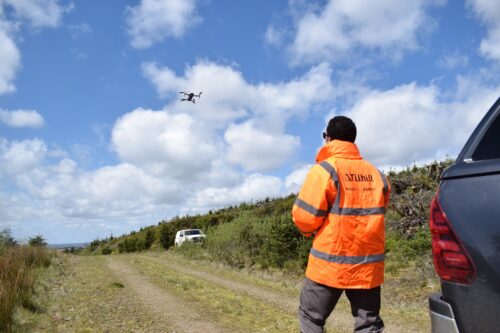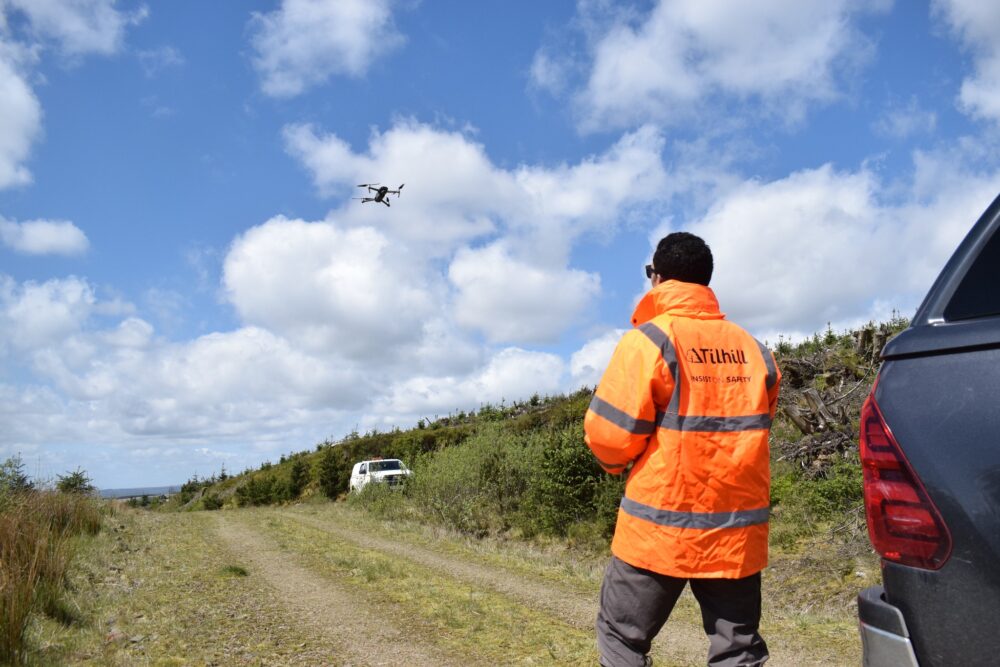Challenges
My experience up North has proved challenging in different ways. The starkest comparison has been the scale of operations, with some properties upwards of 1000 hectares. Naturally, such forests require more data collection, more supervision, more trees… and being in Scotland – more warm layers when out on site! Predominantly working around Moffat and Eskdalemuir, meant that it has been comparatively more remote. It did not take long to realise the importance of stringent health & safety measures (for example surrounding lone working), as well as owning a decent pair of boots.
Windblow

Example of windblow in the uplands – just outside of Moffat.
The upland environment is characterised by exposed slopes and a harsh climate. As a result, windblow played a significant role in the day-to-day life in the office – to give some context, the impact from Storm Arwen caused one of our managed properties to sustain 40 hectares of damage in a matter of days. The topic of windblow has therefore been a recurring theme, with much of the work related to assessing the extent of damage, amending forest management plans and re-thinking patterns of felling and road infrastructure necessary to facilitate harvesting. For me personally, this has led to analysing windblow damage via drone flights and GIS, amending production forecasts and long-term forest plans and planning road building permissions to access blown timber.

Restructuring Forests
Another aspect has been the difference in forest structure and composition. It is no secret that the uplands harbour the majority of the UK’s commercial forest, dominated by productive conifers such as spruce, larch, fir, and pines. Many first rotation forests planted in the 1970’s encompass large-contiguous stands of single (aforementioned) species, uniform in age and structure. Although work has been well-underway restructuring these forests towards more diverse, resilient and considered systems (for example, through phased felling/restocking and UKFS compliant-forest management plans), dealing with the current environmental pressures placed on such systems is part and parcel of the job.
It will be interesting to see how the current influx of budding young foresters consider, plan for and address the challenges future climate scenarios and other anthropogenic pressures may place on our forests.
Pests and Diseases
As well as windblow, Britain’s upland forestry is susceptible to introduced diseases like Phytophora ramorum, and more recently P. pluvialis. As a result of a national attempt to limit the spread of the P. ramorum further North, another frequent task involves dealing with Statutory Plant Health Notices (SPHN). As with windblow, consequently this meant that many long-term plans needed reconsidering. My role involved helping to manage the identification, mapping and production forecast of stands of infected larch to aid thinning, or clear-felling operations. Whilst the success of this national approach remains to be seen, behind the scenes, forest managers have been dealing with a variety of associated challenges such as accessing isolated stands of larch on steep slopes, dealing with immature stands intimately mixed with spruce, and the safe felling of diseased and dangerous trees (often in very challenging conditions).

Phytophthora pluvialis lesions on a tree stem
Forest Management
Other aspects of the job have included helping to manage restocking, beating up, and ground preparation, as well as completing UKWAS plans, felling licences, ecological surveys/permissions, forest mensuration and many other year-round forestry operations. The importance of GIS in comparison to my previous role has been obvious. Due to the extent of the forest properties, acquiring and keeping adequate records of data such as stand condition/composition, environmental features, hazards, and constraints has been important in making everything run efficiently and safely. At scale, modern-day forest management increasingly relies on this type of technology.
From Scotland to Wales
After a fantastic time with Tilhill in Scotland, I have recently taken up a post in South Wales. Drawing on my previous two experiences in both the lowlands and uplands of Britain has given me a great insight into what it takes to manage these different environments effectively. I am sure South Wales will present its own challenges and opportunities, but I know I am looking forward to enjoying the best of both worlds!



